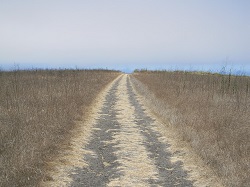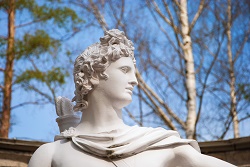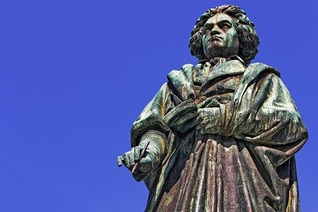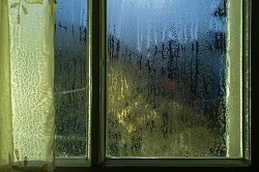
Art Songs
What’s the Destination in “Song of the Open Road”?

Short answer: It’s not the destination but the journey. (You’ve read that on a poster somewhere, haven’t you?)
First some information on Norman Dello Joio (whom I was at first confusing with Ola Gjello). Dello Joio had a fascinating life and career. He was descended from an Italian family known for producing church organists, and he himself became one at age fourteen at the St. Mary Star of the Sea church in the Bronx. (Isn’t that a cool name for church? If you’d like to read an explanation of why Mary would be associated with this title, go to my post here.) His father was a teacher and performer, and his childhood was full of music and also musical glamour, as some of his father’s voice students were from the Metropolitan Opera and would arrive for their lessons in their Rolls Royces. Dello Joio was given a scholarship to Julliard and then went on to graduate studies there, ultimately deciding that he didn’t want to spend the rest of his life in church organ lofts. Instead he pursued a career as a composer, studying composition in 1941 with the great German composer Paul Hindemith at Yale. (Hindemith had emigrated to the US from Germany in 1940.) Hindemith encouraged Dello Joio to remember that his (that is, DJ’s) music was “lyrical by nature.” Dello Joio said that he hadn’t understood Hindemith’s statement at the time but realized later that he meant, “Don’t sacrifice necessarily to a system, go to yourself, what you hear. If it’s valid, and it’s good, put it down in your mind. Don’t say I have to do this because the system tells me to. No, that’s a mistake.” (This information is from the Dello Joio official website; you can read more about his life by going here.) Dello Joio went on to have an extremely successful career as a composer, with his latest work dating to 2003, five years before his death, when he was ninety.
A Charming Fable that Deserves More Fame

How does this whole commissioning process work?
 Note to readers: This post was originally written in connection with a March 2016 concert by my own choir. I have left it as is, since it contains quite a bit of information about how commissions work and therefore should be of general interest.
Note to readers: This post was originally written in connection with a March 2016 concert by my own choir. I have left it as is, since it contains quite a bit of information about how commissions work and therefore should be of general interest.
So I started out by saying that we (that is, the Cherry Creek Chorale in the Denver area) had a number of commissioned pieces on our program for this concert, which raised the question above. So how does it all work?
Well, it depends. If I were to commission a wall hanging by a local artist to put in the stairwell of my home, that original physical item would belong to me. Beyond that ownership, though, there could be a number of permutations. I would have to spell out what other rights I wanted to purchase along with the item itself: Would I own the rights to the image or design? Could I make prints or copies of it and sell them? Would I have to give credit to the artist any time that a picture of my home was published that included the stairwell? Etc. It’s a very interesting and complicated issue.
Can the Lyrics in Our Set of “Birder” Pieces Be Explained?
 I will start out this post by quoting myself (how’s that for arrogance?) from what I wrote about the William Agee poem “This Shining Night” from a previous Christmas concert: “Poetry isn’t supposed to be an art form that can be reduced to simple explanations; otherwise, why write the poem at all? Just explain what you’re trying to say in a clear, concise paragraph and forget the versifying.” You can enjoy the imagery and wit in these four short lyrics without having any explanation or context. But if you’re like me, you’ll appreciate the words much more if you have some sort of context for them. I was very fortunate to find an article from The Guardian newspaper in its “poem of the week” column that makes various meanings clear without trying to take out all the mystery. I’d highly recommend reading it. (You can also read the poems in their entirety there. They are of course copyrighted, so I am including only short extracts below with the kind permission of the author, Gwyneth Lewis, and her publisher, Bloodaxe Books. Wouldn’t you just love to know how they came up with the name of that publisher? I don’t see any explanation on their website.)
I will start out this post by quoting myself (how’s that for arrogance?) from what I wrote about the William Agee poem “This Shining Night” from a previous Christmas concert: “Poetry isn’t supposed to be an art form that can be reduced to simple explanations; otherwise, why write the poem at all? Just explain what you’re trying to say in a clear, concise paragraph and forget the versifying.” You can enjoy the imagery and wit in these four short lyrics without having any explanation or context. But if you’re like me, you’ll appreciate the words much more if you have some sort of context for them. I was very fortunate to find an article from The Guardian newspaper in its “poem of the week” column that makes various meanings clear without trying to take out all the mystery. I’d highly recommend reading it. (You can also read the poems in their entirety there. They are of course copyrighted, so I am including only short extracts below with the kind permission of the author, Gwyneth Lewis, and her publisher, Bloodaxe Books. Wouldn’t you just love to know how they came up with the name of that publisher? I don’t see any explanation on their website.)
Eric Whitacre’s Sweet Seal Lullaby

Note to readers: This post originally was originally written in reference to a Christmas concert by my own choir; thus the holiday reference.
Why are we singing a lullaby to a seal? Are seals somehow part of the Christmas story?
Let’s get the connection between seals (the animals) and Christmas out of the way first. There isn’t one. So that’s settled. (There are Christmas seals of another type,, though—remember those? The little stamps with holiday themes that you’d stick on the envelope flap of your Christmas cards? They’re issued by the American Lung Association and have been around since 1907, when the main push was to find a cure for tuberculosis. As I revise this post in the fall of 2020 they’ve shifted focus to COVID-19. You can still order them and also post them digitally to Facebook, etc.)
A Litany of Sad Lives–but with a Prayer for Hope and Peace

I first had the opportunity to sing Franz Schubert’s lovely “Litanei auf das Fest Aller Seelen” (Litany for the Feast of All Souls) in a concert with a Hallowe’en theme. Weird, huh? Well, actually not. I’m going to take a little time here to explain this Roman Catholic holiday, an occasion that’s not at all well known today. There are actually three holidays in a row right at the beginning of winter: Halloween, or “All Hallows’ Eve,” “All Hallows’ (or “All Saints'”) Day,” Nov. 1, and then “All Souls’ Day,” Nov. 2. These three days together form “Hallowmas Season.” I’d encourage you to follow the link above to my other article if you want more information. Basically, though, what it boils down to is that the Roman Catholic church, and to some extent other denominations, took advantage of existing traditions in pagan cultures and put a Christianized spin on them. As winter approached it was natural to think of the death of loved ones as the year itself was dying. The saints (those who, according to RC doctrine, were especially holy) got their day first on Nov. 1, and then everyone else (“all souls”) came in on Nov. 2.
Why Did Beethoven Put a Chorus In His Ninth Symphony?
 Short answer: We don’t know. Where does any creative artist get the idea for any of his creations?
Short answer: We don’t know. Where does any creative artist get the idea for any of his creations?
So much for that. We’ll never know how the thought welled up in Beethoven’s mind that it would be a cool idea to have a choir march out at the end of the fourth movement. We do know, however, that he had been interested for some time in creating new forms of music. He had already created a hybrid piano concerto/choral work in his “Choral Fantasy,” a 20-minute piece whose words and music are very much a precursor to the Ninth; Beethoven himself said in a letter that the symphony was “a setting of the words of Schiller’s immortal ‘Lied an die Freude’ in the same way as my pianoforte fantasia with chorus, but on a far grander scale.”
The Inspiration for Sid Robinovitch’s “Canciones por las Americas”

One of the great pleasures of writing the posts on this site is that I’m sometimes able to get in touch with living composers and badger them with nosy questions. I was extremely curious about this set of songs because they all have Spanish texts, and yet Sid Robinovitch is Canadian, has a Jewish background, and wrote the pieces as a commission for the Association of Canadian Choral Conductors. There didn’t seem to be much of a Latin tango connection in any of this. So originally I professed my mystification and moved on, but later it occurred to me that I could just ask. I e-mailed Robinovitch after looking up his contact info on his website, and here is part of his very gracious and prompt reply:
A Choral Commission
 Have you ever noticed the words “commissioned by” or “in honor of” at the top of a song or other musical composition? My own choir has actually commissioned several works over its history. I wrote this piece about a new one, and our relationship to both the commissioner and the commissionee was pretty special.
Have you ever noticed the words “commissioned by” or “in honor of” at the top of a song or other musical composition? My own choir has actually commissioned several works over its history. I wrote this piece about a new one, and our relationship to both the commissioner and the commissionee was pretty special.
What three strands produced our selection “Friendship” by K. Lee Scott?
